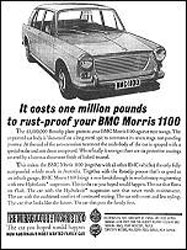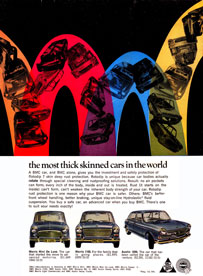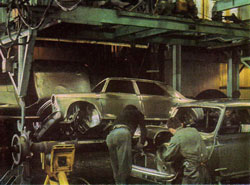The Rotodip Process
 The "Rotodip" process was so named because it quite simply consisted of rotating the bare metal car bodies longitudinally as they were dipped into a succession of chemicals. Many other manufacturers dipped their car bodies for rustproofing but because they did not rotate them, it was all too easy to trap air in the cavities and these areas then missed out on the treatment.
The "Rotodip" process was so named because it quite simply consisted of rotating the bare metal car bodies longitudinally as they were dipped into a succession of chemicals. Many other manufacturers dipped their car bodies for rustproofing but because they did not rotate them, it was all too easy to trap air in the cavities and these areas then missed out on the treatment.
The BMC car bodies each travelled over 100 metres during the 2½ hours they spent undergoing the Rotodip treatment beginning with cleaning and rinsing, then phosphating, drying, dipping into primer, and finally, baking.
The primed bodies were then ready for preparation and spraying of the primer/surfacer, sealer and two coats of enamel in the spray booth. By this stage the finished bodies had a seven layer "skin".

 It is perhaps ironic that BMC Australia spent so much money rustproofing their cars when it is rust that is often blamed for demise of the typical 1100.
It is perhaps ironic that BMC Australia spent so much money rustproofing their cars when it is rust that is often blamed for demise of the typical 1100. However, it is unlikely that any reasonable amount of rust proofing would have protected the few serious water/mud traps that the 1100 body shell had - but that is another story.